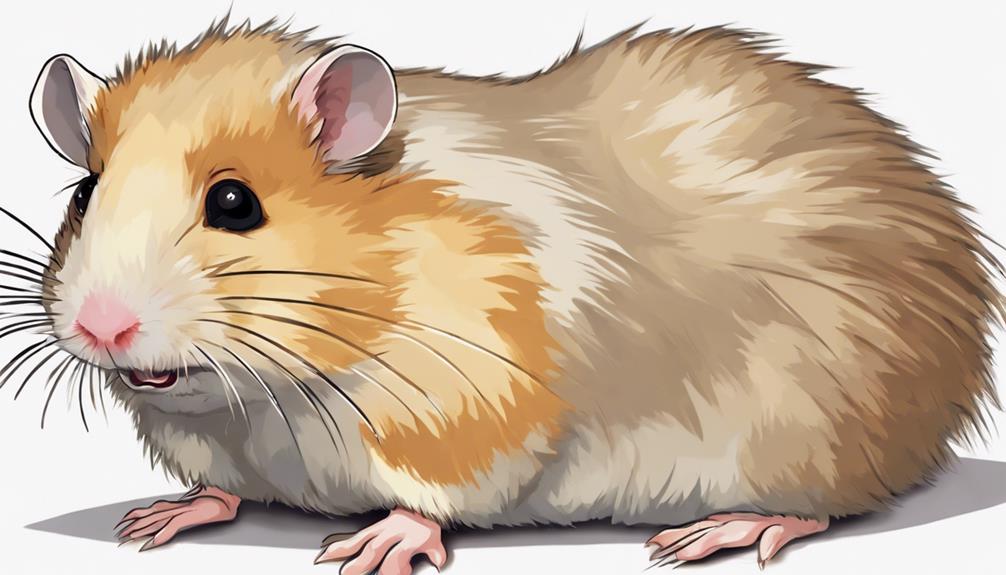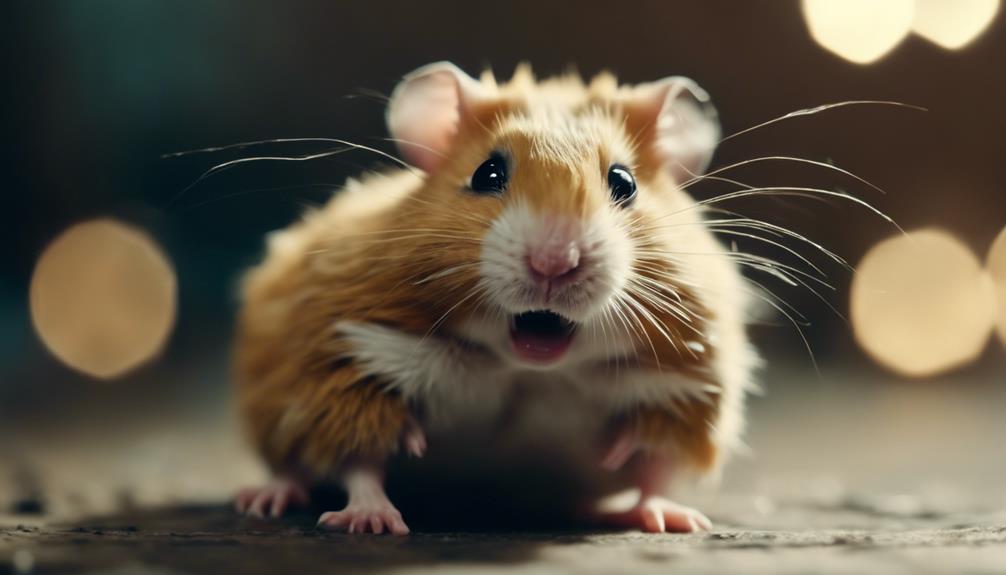How to Spot the Early Signs of Aging in Hamsters

Signs of Aging in Hamsters:
- Look for softened fur.
- Notice hesitance in movement.
- Observe gradual weight loss.
Stay alert to these subtle changes for insights into your pet's well-being.
Changes in Fur Quality
When observing aging hamsters, a key indicator to pay attention to is the changes in their fur quality. Grooming habits and shedding patterns become crucial aspects to monitor as hamsters age. As these small creatures mature, their coat color and texture may undergo noticeable alterations. Owners should remain vigilant for any deviations from the norm in their furry companion's grooming routines.
Aging hamsters may exhibit shifts in their shedding patterns, with fur becoming thinner or more sparse. Additionally, changes in coat color could signal underlying health issues or simply be a natural part of the aging process. Owners should take note of any unusual discoloration or dullness in their hamster's fur, as this could indicate various health concerns.
Maintaining awareness of these fur-related changes can aid in the early detection of potential health issues in aging hamsters. By staying attuned to grooming habits, shedding patterns, and coat color and texture, owners can provide the necessary care and attention their furry friends deserve as they gracefully navigate the golden years of their lives.
Decreased Activity Levels
As hamsters age, they may exhibit slower movement than usual, showing less interest in playing and reduced energy levels. These changes in activity levels can be indicative of the natural aging process in hamsters.
Observing and understanding these signs can help caretakers provide appropriate care and support for their aging furry companions.
Slower Movement Than Usual
A noticeable decline in activity levels can often serve as an early indicator of aging in hamsters. Hamster owners may observe slower movement than usual in their furry companions, which could signify the progression of age-related changes.
As hamsters age, their once sprightly demeanor may give way to a more leisurely pace, reflecting the natural slowing down of their bodies. This reduced activity level may also be accompanied by alterations in sleep patterns and changes in appetite.
While these signs are common in aging hamsters, it's essential for owners to monitor these changes closely and provide the necessary care and attention to ensure their beloved pets remain comfortable and content in their golden years.
Less Interest in Playing
Amidst the aging process, hamsters may exhibit a diminished inclination towards play, displaying decreased activity levels as a notable indication of advancing years. Playtime preferences that were once a source of joy and energy may gradually wane, with hamsters showing less enthusiasm for their usual toys or interactive activities.
Owners may observe a shift in their pet's activity engagement, noticing a reduction in the time spent running on their wheel or exploring their habitat. This change in behavior can be a subtle yet significant sign of aging in hamsters. It's essential for caretakers to acknowledge and respect these shifts in play behavior, providing comfort and support as their furry companions adapt to their changing needs.
Reduced Energy Levels
Hamsters entering their senior years may manifest a noticeable decline in their energy levels, marked by a reduction in overall activity and vigor. This decrease in energy can be attributed to various factors, including changes in metabolism, reduced muscle mass, and altered hormone levels.
To support senior hamsters' well-being, it's crucial to adjust their nutrition needs and exercise requirements. Providing a balanced diet rich in essential nutrients such as protein, fiber, and vitamins is essential for maintaining their energy levels. Additionally, incorporating gentle exercise routines tailored to their abilities can help improve circulation, muscle tone, and overall vitality.
Weight Loss
Among the subtle indicators of aging in these small creatures is the gradual but noticeable weight loss. As hamsters age, changes in their metabolic rate can lead to a decrease in muscle mass, contributing to this weight loss. It's essential for hamster owners to be observant and proactive in monitoring their pet's weight to detect any early signs of aging.
Here are three key points to consider:
- Changes in Appetite: Keep an eye on your hamster's eating habits. A decrease in appetite could be a sign of aging or an underlying health issue.
- Exercise Routines: Encourage your hamster to stay active. Reduced activity levels can lead to muscle loss and weight decline.
- Metabolic Rate: Understand that aging can slow down your hamster's metabolism, making weight management more challenging.
Dental Issues

Hamsters, like all creatures, are susceptible to dental wear and tear as they age. Changes in tooth color can signify underlying dental issues that may require attention.
Monitoring these signs is crucial in ensuring the overall well-being of your aging hamster.
Dental Wear and Tear
With age, hamsters may exhibit noticeable dental wear and tear, which can lead to various dental issues affecting their overall well-being. It's crucial to pay attention to their dental health to ensure they lead a comfortable life. Here are some key points to consider:
- Diet Impact: A balanced diet is essential for maintaining healthy teeth and gums.
- Oral Hygiene: Regularly checking and cleaning your hamster's teeth can prevent the build-up of plaque and tartar.
- Chew Toys: Providing appropriate chew toys can help wear down their teeth naturally, preventing overgrowth and potential dental problems.
Changes in Tooth Color
As hamsters age, observing changes in tooth color can serve as a valuable indicator of underlying dental issues that may impact their overall health and comfort. Dental hygiene plays a crucial role in maintaining healthy teeth in hamsters. A balanced diet rich in essential nutrients also contributes to their dental well-being, preventing discoloration and decay. When hamster teeth start to show signs of yellowing or browning, it could signal potential problems such as tartar buildup, enamel erosion, or even tooth infections. Being proactive in monitoring these changes and addressing them promptly through proper dental care can help ensure your furry friend maintains good oral health as they age.
| Signs of Dental Issues |
|---|
| Yellowing of Teeth |
| Brown Spots on Teeth |
| Difficulty Eating |
| Drooling |
| Bad Breath |
Eye Problems
One of the key indicators of aging in hamsters involves the development of various eye problems that can affect their health and well-being. As these tiny creatures age, their eyes may start to show signs of wear and tear. Here are some important points to consider regarding eye problems in aging hamsters:
- Vision Impairment: Hamsters may experience a decline in their vision as they age, leading to difficulties in navigating their environment. Providing proper lighting and ensuring their living space is free of obstacles can help alleviate this issue.
- Treatment Options: If vision impairment is detected, consulting a veterinarian specialized in exotic pets is recommended. They can suggest appropriate treatments or management strategies to improve the hamster's quality of life.
- Eye Health Prevention: Regularly monitoring your hamster's eye health is crucial. Keep an eye out for symptoms such as cloudiness, redness, or discharge, and seek veterinary advice promptly to prevent any potential eye-related issues from escalating.
Joint Stiffness

Aging hamsters may experience joint stiffness, impacting their mobility and overall comfort. This stiffness can make simple movements like climbing, running on the wheel, or even grooming themselves challenging. To help alleviate joint stiffness in aging hamsters, incorporating dietary supplements rich in glucosamine and chondroitin can be beneficial. These supplements can aid in maintaining joint health and reducing inflammation, ultimately improving flexibility and mobility.
In addition to dietary supplements, implementing gentle exercise routines can also be beneficial for hamsters experiencing joint stiffness. Encouraging light activities such as gentle stretching or short walks in a safe and comfortable environment can help keep their joints mobile and improve circulation. It's essential to introduce these exercises gradually and monitor your hamster's response to ensure they're comfortable and not experiencing any pain.
Behavioral Changes
Behold, the subtle yet profound shifts in behavior that may manifest as a hamster ages can offer invaluable insights into their well-being and state of comfort. As these furry companions grow older, their behavior may undergo subtle transformations that keen observers can pick up on.
Here are some key behavioral changes to watch out for:
- Altered Sleep Patterns: Keep an eye on your hamster's sleep habits. Changes in their sleep patterns, such as increased lethargy during the day or restlessness at night, could indicate age-related issues.
- Appetite Changes: A hamster's appetite can be a telling sign of their health. If you notice a decrease or increase in their food intake, it might be worth investigating further to ensure they're getting the nutrition they need.
- Activity Levels: Older hamsters may exhibit a decrease in their usual activity levels. If your hamster seems less interested in their usual toys or wheel, it could be a sign of aging.
Skin Changes

As hamsters age, subtle changes in their skin may become apparent, serving as a visual indicator of the passing years and potential health concerns. One of the most common skin changes observed in aging hamsters is the development of wrinkled skin. Just like in humans, the elasticity of a hamster's skin decreases over time, leading to the formation of fine lines and wrinkles. These wrinkles are often more noticeable around the face and neck area but can also appear on other parts of the body.
In addition to wrinkled skin, another skin change to watch for is the presence of dry patches. As hamsters age, their skin may become drier and lose some of its natural moisture. This can manifest as rough, flaky areas on the skin that may be itchy or uncomfortable for the hamster. Providing proper hydration and moisturization can help alleviate dry patches and keep the hamster's skin healthy and supple as it ages. Regularly monitoring your hamster's skin for these changes can aid in early detection of potential health issues and ensure your furry friend's well-being in its senior years.
Frequently Asked Questions
Can Hamsters Develop Age-Related Illnesses Similar to Humans?
Hamsters can indeed develop age-related illnesses similar to humans. To prevent such issues, it's important to understand the aging process in hamsters and ensure they have a healthy lifestyle to maximize their lifespan.
What Are Some Ways to Help Prevent or Slow Down the Aging Process in Hamsters?
To help prevent or slow down the aging process in hamsters, they must engage in enriching activities and exercise routines. Providing proper nutritional supplements and maintaining good dental care are also crucial in ensuring their well-being.
How Often Should I Take My Aging Hamster to the Vet for Check-Ups?
Regular check-ups are key to ensuring your aging hamster's well-being. Monitoring health through vet visits, typically every 6-12 months, allows for early detection of any issues. This proactive approach can help maintain your furry friend's quality of life.
Are There Any Specific Dietary Changes I Should Make for My Aging Hamster?
When considering dietary changes for an aging hamster, it's essential to consult a veterinarian. They may recommend specific dietary supplements tailored to the hamster's needs. Additionally, adjusting exercise routines can promote overall health and well-being.
How Long Can Hamsters Typically Live for and What Are Some Signs That They May Be Reaching the End of Their Lifespan?
The lifespan of a hamster ranges from 2-3 years. Signs of aging in hamsters include decreased activity, weight loss, cloudy eyes, and overgrown teeth. Observing these changes can help owners provide appropriate care.









